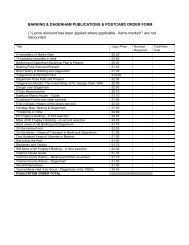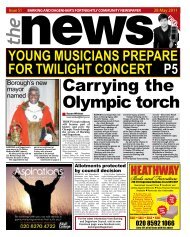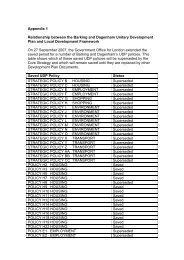Contents - Barking & Dagenham
Contents - Barking & Dagenham
Contents - Barking & Dagenham
Create successful ePaper yourself
Turn your PDF publications into a flip-book with our unique Google optimized e-Paper software.
<strong>Barking</strong> Station Interchange<br />
Egress Analysis<br />
The survey questioned by what mode people would leave <strong>Barking</strong> Station and to what purpose<br />
they were travelling.<br />
Just over half of those surveyed were travelling for work purposes; including to get to their main<br />
place of work. Other major destination groups included home, education and sport and recreation.<br />
Shopping was another important destination – on the day of the survey <strong>Barking</strong> market was taking<br />
place.<br />
Egress Mode<br />
As would be expected 90% of respondent said they were leaving the station using rail based<br />
forms of transport; with national rail taking 2/3 of these. 8% were leaving the station on foot and a<br />
further 2% by bus. One respondent mentioned they’d use a taxi. These figures confirm the<br />
importance of public transport, with the low results for bus probably due to the difficulties in<br />
surveying people as they exit the station.<br />
Destination Purpose<br />
The final destination postcode information has been combined with the description provided for<br />
the journey purpose being made from <strong>Barking</strong> Station. Figure 2.5 illustrates the distribution of<br />
destinations and the destination purpose of those using the station on the survey day.<br />
5062859/_04 <strong>Barking</strong> Interchange Stage 1 Report TP.doc<br />
Figure 2.5 – Destination Purpose<br />
The map above clearly shows a concentration along the railway lines that serve <strong>Barking</strong> station,<br />
and also that the majority of those people surveyed were travelling for work related purposes<br />
(yellow). This is backed up by the concentrations in the large employment areas of the City and<br />
West End of London. There is a wider spread of destinations compared to origins. A possible<br />
explanation for this is that the surveys were carried out during the morning. If similar interviews<br />
were undertaken during the evening peak, we would expect many people to be returning to their<br />
homes that are located close to <strong>Barking</strong> station.<br />
50












